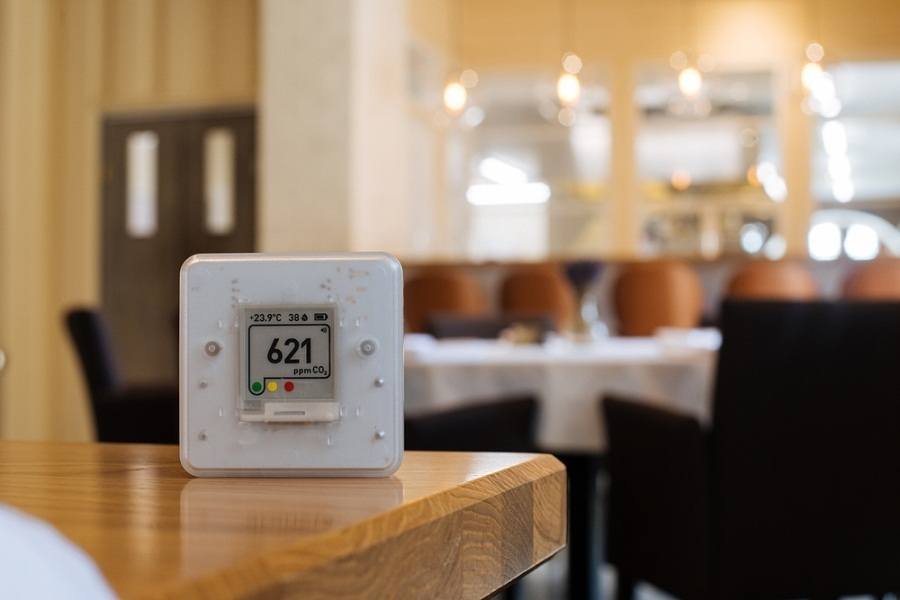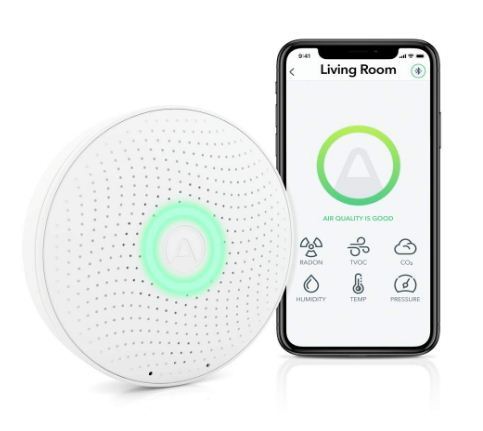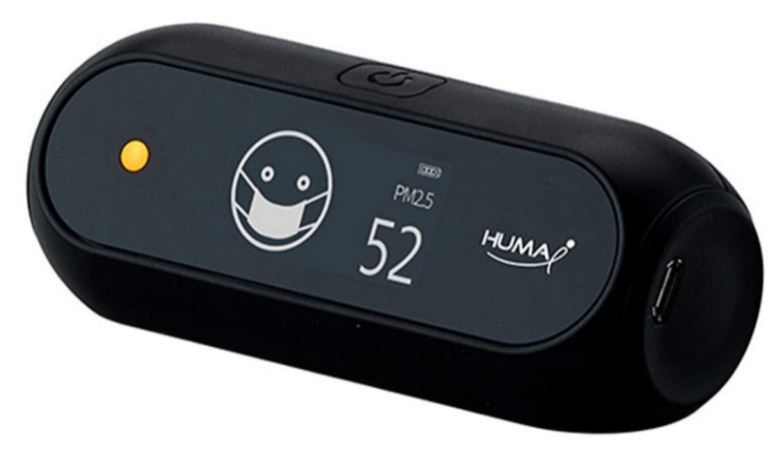Shopping for an Air Quality Monitor?
Take a look at our top picks.
An air quality monitor gives you accurate readings of various air pollutants floating in the air inside your home.
Whether you are just interested in creating a healthier indoor environment for yourself and your family or if you suffer from serious health conditions like asthma, this convenient device lets you keep a constant and close eye on the air quality inside your home.
While air quality monitors were expensive earlier, you can now get a good model for under $100. Of course, the higher-quality professional-grade models are more expensive, but their lower-cost variations are quite suitable for day-to-day usage.
Whether you want to measure particulate matter around your home, or are looking to monitor specific pollutants like VOCs, carbon monoxide, radon, or nitrogen dioxide, here are the best indoor air quality monitors for you to check out.
What’s In This Buying Guide
Indoor air quality can be far worse than outdoor air quality. So much so that it can even achieve alarmingly low air quality levels that are around 50 to 100 times worse than the great outdoors.
In this buying guide, we review the best air quality monitors for indoors. We start with a comprehensive comparison table listing their features and review each product in detail, including their pros, cons, and specs.
We explain the different types of air quality monitors and list some important features to look for in a good air quality monitor.
Lastly, we answer some common questions first-time buyers usually have.
If you are also interested in purchasing a good air purifier, check out our review of the Airmega Smart Air Purifier.
Best Air Quality Monitors
- 1Best Overall: Airthings 2930 Wave Plus
- 2Best Portable: Huma-i HI-150
- 3Best Handheld: EG Air Quality Monitor

Airthings 2930 Wave Plus
- Best Overall
Type of Monitor
Color Light Ring with Mobile Phone ApplicationDimensions
4.75 x 4.75 x 1.4 inchesWeight
7.8 ouncesParameters
Radon, Carbon Dioxide, VOCs, Temperature, Pressure, and HumidityWi-Fi Connectivity
NoSmart Home Integration
Amazon Alexa, Google Assistant, and IFTTT

Huma-i HI-150
- Best Portable
Type of Monitor
Color Indicator Light and OLED displayDimensions
3.58 x 1.61 x 1.46 inchesWeight
2.12 ouncesParameters
PM 2.5, PM 10, TVOCs, CO2, temperature and humidityWi-Fi Connectivity
NoSmart Home Integration
Not Supported
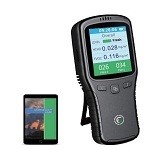
EG Air Quality Monitor
- Best Handheld
Type of Monitor
Color TFT displayDimensions
5.9 x 2.8 x 1.7 inchesWeight
13.12 OuncesParameters
PM 2.5, PM 10, Total VOCs, and FormaldehydeWi-Fi Connectivity
NoSmart Home Integration
Not Supported
1. Best Overall: Airthings 2930 Wave Plus
The Wave Plus is a top-of-the-line air quality monitor by Airthings. It boasts 6 sensors that effectively detect and measure 6 air quality parameters, and these are Radin, carbon dioxide, VOCs, temperature, pressure, and humidity levels.
The air quality is represented as a colored LED ring that changes colors as the air quality improves or declines.
Plus, the Airthings 2930 Wave Plus features an intuitive wall-mount design and comes with a magnetic bracket for installation.
Pros
- Modern and aesthetic design
- The color ring is clearly visible
- Easy-to-read app interface
- Magnetic wall mounting bracket
- Batteries last long
Cons
- Cannot detect particulate matter
- Mobile app requires you to be on the same home network to refresh the data
Our Review
The Airthings 2930 Wave Plus is a smart and reliable way of keeping your indoor air quality in check. It features a simple yet intuitive wall-mount design.
The 2930 Wave Plus has 6 sensors for measuring different parameters. Although the device itself has no buttons, it has a motion sensor.
When you move your hand in front of the device, the LED ring lights up to report the current air quality. Green means the air quality is good, yellow means it is fair, and red means it is poor.
This Airthings device does not have Wi-Fi connectivity, but the integrated Bluetooth connectivity allows you to easily and quickly sync the device with your smartphone via the Airthings app.
You can use the app to view detailed information about chemicals, temperature, and radon around your home. Plus, you can get updates and notifications of your local pollen levels.
Airthings 2930 Wave Plus runs on 2 AA batteries, so there is no need to place it near an electrical outlet. It boasts low-power consumption, with a pair of batteries lasting up to a year.
The 2930 also features a power indicator that flashes every 20 seconds. It flashes green when the batteries are good but turns red when the batteries need replacement. And, when the app communication is active, the indicator turns blue, so there’s no guesswork involved.
Specs
Dimensions: 4.75 x 4.75 x 1.4 inches
Weight: 7.8 ounces
Number of Sensors: 6
Power Source: 2 AA batteries
Smartphone Application: Airthings App and Airthings Hub
Placement: Wall-mounted
Warranty: 1 year
2. Best Portable: Huma-i HI-150
Huma-i HI-150 is a simple, portable air quality monitor. The compact HI-150 easily fits inside your purse or pocket so that you can take it with you anywhere you go. It is great for both indoor and outdoor air monitoring.
The Huma-i HI-150 features an OLED screen that displays air quality parameters in graph form. But if you switch to the WHO mode, this Huma-i device shows a quick and simple emoji to indicate your current level of air quality.
Pros
- Simple and easy to use
- Small, compact, and highly portable
- It comes with a built-in rechargeable battery
- Boasts a WHO mode
- Light indicator and emoji displays indicate air quality
Cons
- No Wi-Fi connectivity
- No smartphone application support
Our Review
When you or your loved one suffers from allergies, you need to have an air quality monitor on yourself at all times. The Huma-i HI-150 is perhaps the best device for such users. It features a simple and compact design that fits inside most purses and pockets.
Using this Huma-i device is fairly simple. It incorporates high-quality sensors and a fan that ensure accurate readings every single time. Just press the button, and the HI-150 pulls in some air to take a snapshot of its quality.
The HI-150 displays information in two ways. It displays the air quality in a horizontal bar graph form, with a separate bar for each parameter. And if you choose the WHO mode, the device displays a cute emoji telling you about the air quality around you.
Plus, this Huma-i air quality monitor has a status light that displays different colors for quick air quality information.
The HI-150 accurately measures PM 2.5, PM 10, humidity, temperature, total VOCs, and carbon dioxide levels. You can use it to measure both indoor and outdoor air quality levels, so you can use it around your home, workplace, car, or even while traveling.
With its built-in rechargeable battery, you also don’t need an external power source. Plus, a battery status indicator on top of the device keeps you informed of the battery left.
Specs
Dimensions: 3.58 x 1.61 x 1.46 inches
Weight: 2.12 ounces
Number of Sensors: 6
Power Source: Internal rechargeable battery
Smartphone Application: No
Placement: Portable pocket-sized device
Warranty: 1 year
3. Best Handheld Air Quality Monitor: EG Air Quality Monitor
The EH Air Quality Monitor is an affordable handheld indoor air quality monitor that offers some bells and whistles of more expensive units. It features a 2.8-inch colored LCD that lets you view different parameters levels in 2 different interfaces.
This EG device uses a laser sensor along with an electrochemical semiconductor to measure formaldehyde, total VOCs, PM 2.5, and PM 10 levels. The colorful display presents the current readings and changes color to indicate if they’re at dangerous levels.
Pros
- 2.8-inch color LCD
- Includes a 20+ page eBook on gas and air quality hazards
- Portable and lightweight
- Simple and easy to use
Cons
- No Wi-Fi connectivity
- The basic version does not measure temperature and humidity levels
Our Review
The EG Air Quality Monitor can keep several dangerous parameters in check. It can accurately measure total VOC levels, whether natural or synthetic, formaldehyde, PM 2.5, and PM 10. Each air contaminant is displayed differently in 2 display interfaces.
The first is the default mode that shows the exact measurements of each parameter. The second is a windows-inspired interface where each parameter has a separate tile. In both interfaces, the color changes indicate the air quality status.
This EG unit is one of the most accurate air monitors out there.
It uses advanced filtration technology that eliminates any interference that can disrupt the readings’ accuracy.
And then, a built-in fan and extremely accurate laser and electrochemical sensors precisely measure each harmful contaminant. The EG air quality sensor is even capable of measuring these compounds all the way down to zero.
The best thing about the EG Air Quality Monitor is that you can use it as a portable handheld device or use the standing bracket to place it as a stand-alone air quality monitor.
The device functions on a built-in rechargeable battery and comes with a USB charger to keep it going.
Specs
Dimensions: 5.9 x 2.8 x 1.7 inches
Weight: 13.12 ounces
Number of Sensors: 4
Power Source: Internal rechargeable battery and USB
Smartphone Application: No
Placement: Handheld
Warranty: Not specified
Air Quality Monitor: Buying Guide
What Is an Air Quality Monitor – and How Does It Work?
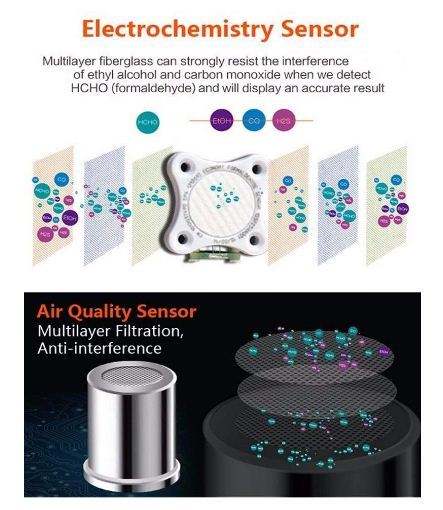
An air quality monitor calculates and reports the level of pollutants in the air.
It can accurately measure various airborne contaminants, including total particulate matter (PM), carbon monoxide, VOCs, Nitrogen dioxide, formaldehyde, and other VOCs. It can also report other useful measurements like humidity, temperature, and air pressure.
Air quality monitors collect all this data to inform you about the quality of the air you are breathing in. If it is bad, you can use the information to do something about it while there’s still time—the more detailed the data, the better steps you can take towards improvement.
These days, you can purchase air quality monitors for both indoor and outdoor air quality.
Here’s how they work.
Air quality monitors are equipped with lasers and sensors that detect different contaminants in the air. They scan the air quality and generate results.
Some models are designed to deliver instant results. Others are programmed to record measurements at regular intervals.
Types of Air Quality Monitors
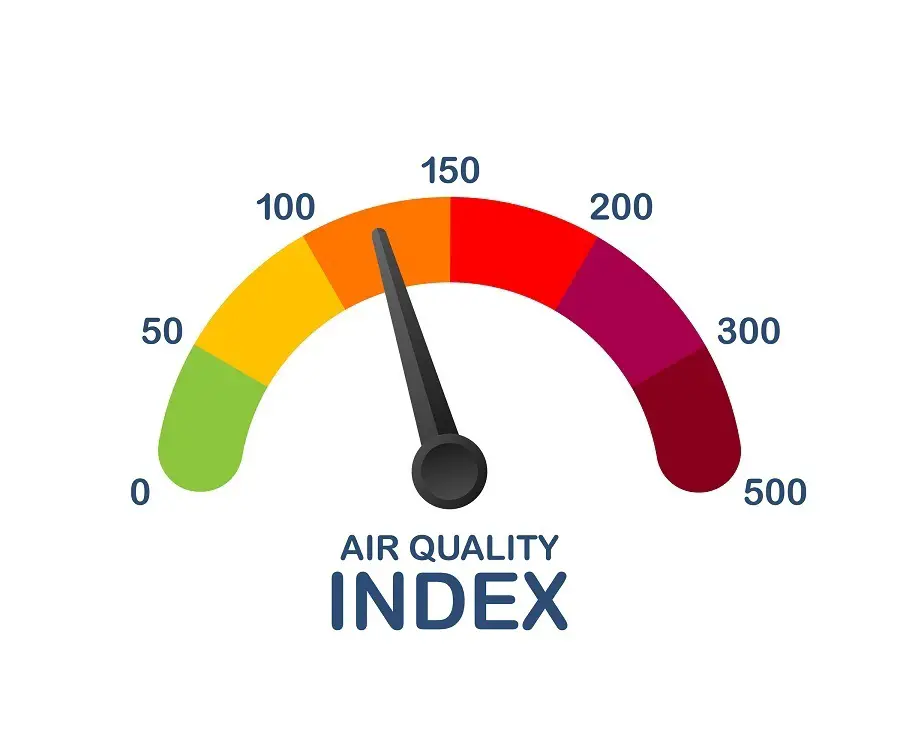
Some air quality monitors are standalone units that display the air quality of the room they are placed in. Others are portable devices that you can take with you anywhere. Then, some devices record and display results directly on your smartphone over Wi-Fi.
Depending on their method of usage, the following are the types of air quality monitors.
Portable Air Quality Monitors
These are the most convenient types of air quality monitors. As the name suggests, you can take them to any place where you want to assess the air quality. They don't have wires that tie them to a single place.
They are usually quite small, with a display to show the result of their scan. Most are easy to read too and show the data collected in a visual form.
Wi-Fi-Enabled Smart Air Quality Monitors
Such devices feature Wi-Fi connectivity, allowing you to control them with your smartphone. They come with a compatible smartphone application that you can use to read the air quality measurement.
You can use Wi-Fi-enabled smart air quality monitors both physically and online to check data remotely. They provide a detailed analysis and allow you to customize data.
But you should also know that these units are not portable. They have to stay plugged in at all times.
Handheld Air Quality Monitors
Handheld versions are the most basic types of air quality monitors. But they are professional favorites because they allow them to measure the pollution levels wherever they go.
Their controls are simple, yet they provide the most accurate readings. You have to hold the device in hand to get the reading. There are no wire restrictions, so you can use them in a variety of spaces.
Why Buy an Air Quality Monitor?
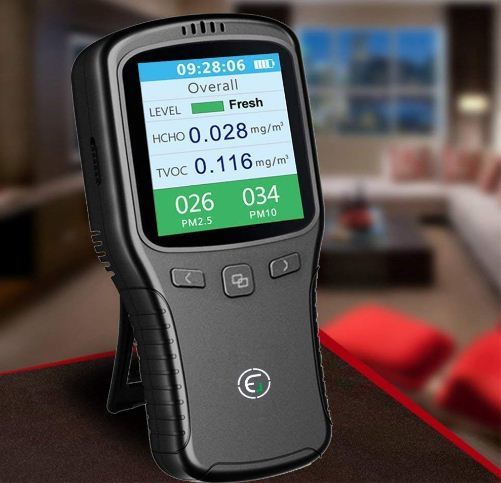
Indoor air pollutants like dust, pollen, and smoke are a major source of allergies and general discomfort.
A good indoor air quality monitor not only enables you to keep an eye on what pollutants are floating inside your home but also helps you find ways to reduce their presence in the future.
Here are some reasons why you should buy an air quality monitor:
Reduce health risks
Poor-quality indoor air carries significant short and long-term health risks for residents. Sensitive people start experiencing symptoms like throat, nose, and eye irritation, headaches, dizziness, nausea, and fatigue.
In severe cases, increased indoor air pollution leads to acute and chronic respiratory illnesses like asthma, lung irritation, pneumonia, chronic obstructive pulmonary disease (COPD), and Legionnaires’ disease.
Using an air quality monitor helps you keep the concentration of indoor pollutants in check, so you can take appropriate steps when they significantly increase. This way, you protect both yourself and your loved ones from their ill effects.
Identify sources of low indoor air quality
Your indoor air quality can get significantly poor because of insufficiently maintained HVAC systems, environmental tobacco smoke, non-vented gas heaters, wood and coal stoves, and of course, exhaust emissions.
Sometimes the materials used in construction, furnishings, carpeting, and cleaning supplies are also responsible for reducing your indoor air quality.
Using an accurate air quality monitor enables you to identify the reasons for poor indoor air quality. Once you know the cause, you can take appropriate steps to reduce its emissions.
Create a better workplace environment

Poor indoor air quality in the workplace can contribute to decreased productivity, absenteeism, and even possible litigation. With an accurate air monitor at hand, you can create a better working environment for your employees.
When workers enjoy a healthier workplace environment with cleaner air, free from potentially harmful chemicals and pollutants, both their retention levels and productivity significantly increase.
What to Look for in an Air Quality Monitor
Buying an air quality monitor for indoors is the first step to gaining control of air quality around your home.
To choose the best air quality monitor, keep an eye out for:
Precision & Accuracy
Not every air quality monitor is programmed using the same technology, which means they don’t share the same level of precision in pollutant detection.
Since you are purchasing an air quality monitor to regulate better indoor quality, precision and accuracy are of utmost importance.
If there are some specific contaminants you are more concerned about, you should go for a monitor that can detect and measure them correctly.
Response Time
An air quality monitor with a shorter response time is definitely a better choice than a unit that takes some time to report its readings.
Some devices provide you with instant results, while others require time.
However, the response time of an air quality monitor is not as simple as that. It is also affected by the type of contaminants it is measuring.
For example, in a space with a dangerously high concentration of harmful gases like carbon monoxide or ozone, the monitor’s response time will be almost instant so that you can leave the area immediately.
But if the concentration is safely low, the device might take its time to accurately measure the concentration and inform you after a few minutes.
Be sure to choose a unit that can gather important information at a much faster rate.
Ease of Use

Most air quality monitors are designed to provide users with a good user experience. They are great for both beginners and pros. They can detect one or two pollutants and don’t require much intervention. You can set them up once and read the measurements when needed.
Advanced models can also detect multiple contaminants and present the results in numerical or graphical form. However, they boast lots of high-tech features that are better suited for advanced users. Some people have a lot of difficulties deciphering granular data.
So, when choosing an air quality monitor for your home, choose one that’s simple and easy to use for you. Even a basic model is fine if it saves you from the hassle of researching how to use an advanced model.
Size & Portability
Although most air quality monitors are quite compact, their widths and heights vary considerably. Their size is important because it helps you determine their placement.
For example, if you want a portable unit, you should get one that easily fits inside your pocket, so you can carry it from home to office without it being bulky or burdening. A heavy and bulky device will be quite awkward to carry around.
On the other hand, if you want to keep the air quality of your living room in check, the size of the device doesn’t matter much because you can place it over a shelf or desktop to measure the pollutants in your living room.
A rectangular-shaped or handheld device is more ergonomic than a uniquely shaped one. So, you should go for a device that is not only easy to hold but also inconspicuous to carry around.
Wi-Fi/Smart Home Connectivity
Air quality monitors with Wi-Fi and smart home connectivity offer more convenience than their regular counterparts. They allow you to remotely track air pollutant levels around your home with your smartphone or tablet.
All you need to do is connect the device to your home internet router and download the compatibility app. Now you can get insight into the air quality through the app.
Power Supply
Air quality monitors are either USB or battery-powered, or they plug into an electrical outlet. If you want a portable device to check air quality in various locations, you should get a battery-operated or USB-powered device.
On the other hand, if you plan on keeping the device in one place, you can also go for a corded one.
How to Use an Air Quality Monitor
Using an air quality monitor is very simple.
It is your first line of defense against air pollution. It enables you to detect and measure invisible airborne particles and helps you pinpoint the source of air pollution.
Here’s how to use an air quality monitor:
Placement
First, you have to decide where you want to place it. Choose a location where you spend most of your time, like in the living room or bedroom. You can also choose the area with maximum outdoor access or the place where your allergy symptoms tend to worsen.
Set up the Wi-Fi
If you have a smart air quality monitor, use the device to scan for your home Wi-Fi network. Put in the password and grant it access.
Download and set up the proprietary app
Now open up the app store and download the proprietary application onto your smartphone or tablet. Open it to sync your air quality monitor with your device.
Now with this app, you can check the air quality data in real-time, both physically and remotely.
In the app interface, you will find all the information about the different contaminants floating into your indoor atmosphere, along with their concentration. You can use this data to eliminate them more effectively.
Turn on push notifications
If you want to receive air quality alerts on your device, be sure to keep push notifications on in the application.
Pros and Cons of Using the Air Quality Monitor
While indoor air quality monitors play a significant role in improving our quality of life, they have some limitations.
Pros
Help create a better indoor environment
Whether at home or work, having an indoor air quality monitor ensures you breathe in the highest air quality possible. It can help you detect and measure the different air pollutants present in your atmosphere.
As they say, what can be measured can be managed, so the simple knowledge of their presence allows you to do something about it.
You can install an air purifier to maintain a better indoor air environment or remove the source of pollution entirely.
Allow you to manage allergic symptoms and triggers better
Indoor air quality monitoring helps you better manage your allergy symptoms.
If you know the specific contaminants you are allergic to, you can use your air monitor to learn about their presence.
When their concentration is high, you know that you should avoid going in that area. Plus, you can take appropriate steps for their removal.
Ensure workplace productivity
Workplaces without proper air monitoring and cleaning usually have decreased productivity. Contaminant-rich air is quite difficult to breathe in, which is why employees who work there often feel lethargic, unmotivated, and generally tired.
Using a quality air monitoring system lets you identify contaminants ruining the air quality and helps you eliminate them to create a healthier and more productive workplace environment.
Help you adopt more eco-friendly ways
Non-vented gas heaters, wood and coal stoves, and tobacco smoke are some major causes of increased air pollution.
Using an indoor air quality monitor helps you realize how much air pollutants these common practices add to the air. It makes you feel more concerned about the global air pollution problem and prompts you to adopt better alternatives that don’t cause as much air pollution.
Cons
Not every device is accurate
Not every device is highly accurate in air quality reporting. Where most high-quality devices are quite accurate, some cheap devices are significantly off.
You have to be careful about choosing an accurate device; otherwise, you won’t be able to achieve your air quality monitoring goals.
Can measure a limited number of contaminants
The air quality monitor market is filled with tons of models, each varying in terms of features. Some devices can measure multiple contaminants, humidity levels, and temperature, while others can only measure one or two contaminants.
Frequently Asked Questions
Can air quality monitors detect dust?
Yes, some air quality monitors can give you an accurate measurement of dust particles floating in the air.
They are usually advanced devices that detect and measure a vast range of airborne contaminants, including VOCs, carbon monoxide, particulate matter (PM), radon, pollen, and other harmful pollutants.
Can air quality monitors detect mold?
Generally, most air quality monitors cannot detect mold. However, you can find some models that detect the mold growing inside your home.
How accurate are air quality monitors?
The precision and accuracy of air quality monitors vary from model to model.
Where some devices are highly accurate, others can be wrong sometimes.
To know the accuracy of your device, check the manufacturer’s description or the user manual.
Is it necessary to monitor air quality?
Indoor air quality monitoring helps assess the level of pollution concerning the ambient air quality standards.
It ensures you live in a healthier indoor environment that makes breathing easy and saves you from the health risks associated with polluted indoor air.
Final Verdict: What is the best air quality monitor sold today?
An air quality monitor helps you keep indoor air pollution in check. It lets you compare your indoor and outdoor air quality and enables you to manage it in a better way.
For us, the best air quality monitor is the Airthings 2930 Wave Plus. Its aesthetic design, smartphone compatibility, and bright LED indicator ring make it a top choice for most buyers.
The Huma-i HI-150 is also a good choice for anyone looking to test air quality on the go. It features a simple and compact, easy-to-use design.
Lastly, the EG Air Quality Monitor is the best handheld air quality monitor that promises great accuracy and portability.

